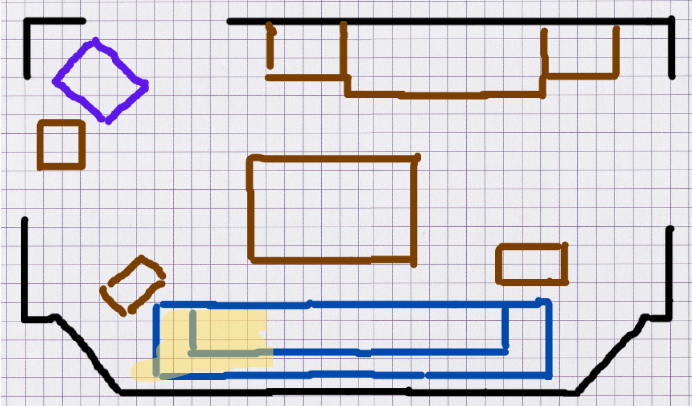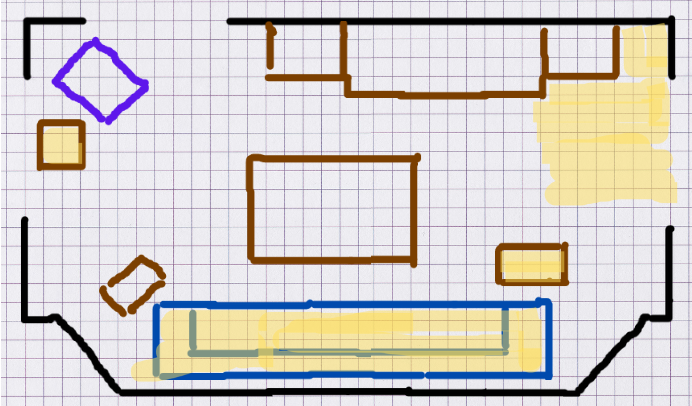Building a Tidying Habit: The Graph Paper Method
Summary: This method provides logistical and emotional support for building a tidying habit if you have ADHD, Autism, or other struggles with executive functioning. Its companion piece, How Executive Functioning Impacts Tidiness, explains the underpinnings of difficulties with tidying. Each step in The Graph Paper Method is intentional, and I encourage you to explore the context that post provides.
Overview
You’re going to draw a map of the horizontal surfaces in your home and color in small areas of progress on your map every day that will correspond to real world progress in your home. This map lets you easily see that you’re carving out progress, even if it’s hard to see in the rooms themselves. It reduces the pressure to figure out where to start: all you have to do is keep plugging away and you will progress.
Tidying in this case means putting objects away where they belong, throwing away trash, neatly arranging anything that permanently lives on the surface, folding blankets that live on the sofa, and so on. Essentially, it means returning a surface to its ideal, orderly state. It does not have to mean cleaning and dusting the surface.
Setup
- Pick the room or rooms in your home where you want to begin your tidying journey. Starting with a room where you spend most of your time is a great beginning.
- Using a sheet of graph paper (or plain paper if graph paper isn’t handy or printable), sketch a two-dimensional, view-from-above floor plan of the furniture and objects that live permanently in the room. Exposed horizontal surfaces only – the objects that collect clutter. Here's an example drawing of my living room, with our blue couch, purple armchair, and assorted tables, shelving units, and TV trays.

- Decide on the minimum amount of time you’ll tidy each day. Try to pick the longest amount of time that will still be easy and doable 100% of the time. Maybe this is 10 minutes. Maybe it is 2 minutes.
- Pick rewards. Reward yourself for starting your tidy habit, reward yourself while you’re doing it, and when you finish it. All the rewards. We’re changing a lifetime of habits here so pull out all the stops to keep yourself feeling good about this new habit.
- Set up reminders. Set a timer on your phone to remind you each day/evening to tidy a surface or portion of a surface. Put sticky notes in visible places you’ll encounter at relevant, helpful times (e.g. the tv remote). Recruit a support system of friends and family to help reinforce the habit. If the people you cohabitate with aren’t on board with tackling the tidying part with you, then ask if they’ll DJ while you tidy. Or buddy up with a friend and text progress photos to one another.
Daily steps
- Speak to yourself with gentle, kind intentions about this habit. Tidiness is hard, and it’s okay that you need scaffolding and support around it. You deserve all the kindness, rewards, and encouragement while you build this habit.
- Each day, pick a surface in the room that you can completely tidy during the time range you’ve selected (e.g. 2 minutes, 5 minutes, 10 minutes). Subdividing areas into multiple days is totally acceptable – heck, you can even divide up portions of the couch or definitely divide up portions of the kitchen counter. Incremental forward progress is the important part here. Include progress on the floor! Make sure the mental and physical energy you have available matches the surface you pick for the day. Be gentle and kind with what you ask of yourself.
- When your reminder chimes, tidy the bit of horizontal surface that you’ve selected.
-
Color in this area on your sketch once you’ve completed it. In my example drawing of my living room, I highlighted a portion of the couch that I tidied, removing stray laundry and pads of paper.

-
Perform a maintenance tidy of all the areas you have already colored in. The only items on the maintenance areas will be items you’ve used today, which hopefully makes the items relatively easy to put away.
Long-term steps
-
Keep tidying areas in your home until all the areas on your map are colored in. Draw an additional map to cover new rooms. This final example drawing shows progress after about a week, with multiple colored-in surfaces that are now tidy.

-
Keep rewarding yourself for maintaining your routine. Switch up the rewards if your motivation begins to wane.
- If your tidiness slips, there could be two issues at play. You might need to mix up your rewards so that keeping the tidiness is more appealing. Or it might be a sign that other parts of your life are overwhelming or a bit too hectic. Consider that the tidiness is a sign of struggle and not any sort of personal failure. It’s OKAY if your house gets messy again because now you’ve got an easy way out before it reaches critical mass.
And that’s it for the graph paper method. There’s a fair bit of purpose and structure behind the method, and I invite you to explore that in How Executive Functioning Impacts Tidiness.
If you found this post helpful, please consider contributing to my Buy Me A Coffee. You can also sign up for my newsletter to get posts delivered to your inbox, or follow me on Facebook or Twitter or Instagram. I write about habits, healthy productivity, ADHD, autism, mental health, and occasionally my special interests.